Coupling Coordination and Spatiotemporal Dynamic Evolution between Agricultural Carbon Emissions and Agricultural Modernization in China 2010–2020
Abstract
1. Introduction
2. Data and Methods
2.1. Data Sources
2.2. Index System of Agricultural Carbon Emissions and Agriculture Modernization
2.2.1. Indicator System of Agricultural Carbon Emissions
2.2.2. Indicator System of Agriculture Modernization
2.3. Carbon Emission Factor Accounting
2.4. Entropy Method
2.5. Spatial Autocorrelation
2.6. Coupling Coordination Degree
3. Results
3.1. Temporal Characteristics of Agricultural Carbon Emissions and Agricultural Modernization
3.2. Spatial Variability Characteristics of Agricultural Carbon Emissions and Agricultural Modernization
3.3. The Coupled and Coordinated Relationship between Agricultural Carbon Emissions and Agricultural Modernization
3.3.1. Temporal Characteristics of Coupling and Coupling Coordination
3.3.2. Temporal Characteristics of Coupling and Coupling Coordination
3.3.3. Spatial Autocorrelation of Coupling Coordination
4. Discussion
4.1. Coupling Coordination Relationship between Agricultural Carbon Emissions and Agricultural Modernization in China
4.2. Factors Influencing Spatial Differences of the Coupling and Coordination of Agricultural Carbon Emissions and Agricultural Modernization
4.3. Policy Recommendations
5. Conclusions
Supplementary Materials
Author Contributions
Funding
Institutional Review Board Statement
Informed Consent Statement
Data Availability Statement
Conflicts of Interest
References
- Bai, Y.P.; Deng, X.Z.; Jiang, S.J.; Zhao, Z.; Miao, Y. Relationship between Climate Change and Low-Carbon Agricultural Production: A Case Study in Hebei Province, China. Ecol. Indic. 2019, 105, 438–447. [Google Scholar] [CrossRef]
- Madden, S.M.; Ryan, A.; Walsh, P. Exploratory Study on Modelling Agricultural Carbon Emissions in Ireland. Agriculture 2022, 12, 12. [Google Scholar] [CrossRef]
- Rosin, Z.M.; Part, T.; Low, M.; Kotowska, D.; Tobolka, M.; Szymanski, P.; Hiron, M. Village Modernization May Contribute More to Farmland Bird Declines Than Agricultural Intensification. Conserv. Lett. 2021, 14, 10. [Google Scholar] [CrossRef]
- Sun, L.Y.; Wang, M.H. Global Warming and Global Dioxide Emission: An Empirical Study. J. Environ. Manage. 1996, 46, 327–343. [Google Scholar] [CrossRef]
- Pickson, R.B.; Gui, P.; Chen, A.; Boateng, E. Empirical Analysis of Rice and Maize Production under Climate Change in China. Environ. Sci. Pollut. Res. 2022, 29, 70242–70261. [Google Scholar] [CrossRef]
- Amin, N.; Song, H.; Farrukh, M.U. Does Sectoral Modernization Promote CO2 Emissions? Dynamic Panel Analysis of Selected Asian Countries. Environ. Sci. Pollut. Res. 2022, 12. [Google Scholar] [CrossRef]
- Chen, X.J.; Zeng, D.; Zhang, H.; Kang, C. Farm Expansion under Credit Constraint: Evidence from Commercial Rice Farmers in Guangxi, China. Int. Food Agribus. Manag. Rev. 2020, 23, 203–215. [Google Scholar] [CrossRef]
- Guo, L.; Zhao, S.; Song, Y.; Tang, M.; Li, H. Green Finance, Chemical Fertilizer Use and Carbon Emissions from Agricultural Production. Agriculture 2022, 12, 313. [Google Scholar] [CrossRef]
- Lin, B.; Xu, M.; Wang, X. Mitigation of Greenhouse Gas Emissions in China’s Agricultural Sector: Current Status and Future Perspectives. Chin. J. Eco-Agric. 2022, 30, 500–515. [Google Scholar]
- Hu, Z.; Zhu, D.; Xin, L.; Hou, L.; Wang, D. Comparison Study on the Level of International Agricultural Modernization Based on the Method of Generation Gap of Industry Elements. Sci. Agric. Sin. 2018, 51, 1412–1420. [Google Scholar]
- Balsalobre-Lorente, D.; Driha, O.M.; Bekun, F.V.; Osundina, O.A. Do Agricultural Activities Induce Carbon Emissions? The Brics Experience. Environ. Sci. Pollut. Res. 2019, 26, 25218–25234. [Google Scholar] [CrossRef]
- Chen, S.; Ji, C.; Jin, S.Q. Costs of an Environmental Regulation in Livestock Farming: Evidence from Pig Production in Rural China. J. Agric. Econ. 2022, 73, 541–563. [Google Scholar] [CrossRef]
- Xiao, Z.M.; Yu, L.; Liu, Y.W.; Bu, X.N.; Yin, Z.C. Does Green Credit Policy Move the Industrial Firms toward a Greener Future? Evidence from a Quasi-Natural Experiment in China. Front. Environ. Sci. 2022, 9, 11. [Google Scholar] [CrossRef]
- Hussain, I.; Rehman, A. How CO2 Emission Interacts with Livestock Production for Environmental Sustainability? Evidence from Pakistan. Environ. Dev. Sustain. 2022, 24, 8545–8565. [Google Scholar] [CrossRef]
- Guo, H.P.; Fan, B.Q.; Pan, C.L. Study on Mechanisms Underlying Changes in Agricultural Carbon Emissions: A Case in Jilin Province, China, 1998–2018. Int. J. Environ. Res. Public Health 2021, 18, 17. [Google Scholar] [CrossRef]
- Xiong, C.; Su, W.; Li, H.; Guo, Z. Influencing Mechanism of Non-CO2 Greenhouse Gas Emissions and Mitigation Strategies of Livestock Sector in Developed Regions of Eastern China: A Case Study of Jiangsu Province. Environ. Sci. Pollut. Res. 2022, 29, 39937–39947. [Google Scholar] [CrossRef]
- Wang, G.; Liao, M.; Jiang, J. Research on Agricultural Carbon Emissions and Regional Carbon Emissions Reduction Strategies in China. Sustainability 2020, 12, 2627. [Google Scholar] [CrossRef]
- Zhang, Z.; Li, Y.; Elahi, E.; Wang, Y. Comprehensive Evaluation of Agricultural Modernization Levels. Sustainability 2022, 14, 5069. [Google Scholar] [CrossRef]
- Chen, K.J.; Tian, G.L.; Tian, Z.; Ren, Y.J.; Liang, W. Evaluation of the Coupled and Coordinated Relationship between Agricultural Modernization and Regional Economic Development under the Rural Revitalization Strategy. Agronomy 2022, 12, 21. [Google Scholar] [CrossRef]
- Liu, M.M.; Pan, P.P.; Ren, J.X.; Wen, J.Y.; Zhang, B. Coupling and Coordination of Food Security and Agricultural Water Security in Beijing-Tianjin-Hebeiregion. J. China Agric. Resour. Reg. Plan. 2022, 78, 287–294. [Google Scholar]
- Han, H.B.; Zhong, Z.Q.; Guo, Y.; Xi, F.; Liu, S.L. Coupling and Decoupling Effects of Agricultural Carbon Emissions in China and Their Driving Factors. Environ. Sci. Pollut. Res. 2018, 25, 25280–25293. [Google Scholar] [CrossRef] [PubMed]
- Min, J.; Hu, H. Calculation of Greenhouse Gases Emission from Agricultural Production in China. Chin. J. Popul. Resour. Environ. 2012, 22, 21–27. [Google Scholar]
- Yin, D.Y.; Yu, H.C.; Ma, J.; Liu, J.N.; Liu, G.J.; Chen, F. Interaction and Coupling Mechanism between Recessive Land Use Transition and Food Security: A Case Study of the Yellow River Basin in China. Agriculture 2022, 12, 21. [Google Scholar] [CrossRef]
- Waldhor, T. The Spatial Autocorrelation Coefficient Moran’s I under Heteroscedasticity. Stat. Med. 1996, 15, 887–892. [Google Scholar] [CrossRef]
- Guo, H.; Yi, X.; Pan, C.; Yang, B.; Li, Y. Analysis on the Temporal and Spatial Features of the Coupling and Coordination of Industrialization and Agricultural Green Development in China During 1990–2019. Int. J. Environ. Res. Public Health 2021, 18, 8320. [Google Scholar] [CrossRef]
- Xu, S.; Zuo, Y.; Law, R.; Zhang, M.; Han, J.; Li, G.; Meng, J. Coupling Coordination and Spatiotemporal Dynamic Evolution between Medical Services and Tourism Development in China. Front. Public Health 2022, 10, 731251. [Google Scholar] [CrossRef]
- Li, Y.; Zhang, X.; Gao, X. An Evaluation of the Coupling Coordination Degree of an Urban Economy–Society–Environment System Based on a Multi-Scenario Analysis: The Case of Chengde City in China. Sustainability 2022, 14, 6790. [Google Scholar] [CrossRef]
- Anselin, L. Local Indicators of Spatial Association—Lisa. Geogr. Anal. 1995, 27, 93–115. [Google Scholar] [CrossRef]
- Anselin, L. The Moran Scatterplot as an Esda Tool to Assess Local Instability in Spatial Association. In Spatial Analytical Perspectives on Gis; Ficher, M.M., Scholten, H.J., Unwin, D., Eds.; Taylor and Francis: London, UK, 1996. [Google Scholar]
- Burney, J.A.; Davis, S.J.; Lobell, D.B. Greenhouse Gas Mitigation by Agricultural Intensification. Proc. Natl. Acad. Sci. USA 2010, 107, 12052–12057. [Google Scholar] [CrossRef]
- Liu, Y.; Zhou, Y.; Zha, H.; Mathieu, S.S. Impact of Financial Subsidies on Ecological Agriculture Benefits: Evidence from China. Transform. Bus. Econ. 2021, 20, 704–722. [Google Scholar]
- Shan, W. Ecological Environment Protection and Agricultural Regional Economic Development in the Yellow River Basin. J. Environ. Prot. Ecol. 2021, 22, 2241–2250. [Google Scholar]
- Jiang, Y.P.; Li, K.R.; Chen, S.F.; Fu, X.L.; Feng, S.Y.; Zhuang, Z.S. A Sustainable Agricultural Supply Chain Considering Substituting Organic Manure for Chemical Fertilizer. Sustain. Prod. Consump. 2022, 29, 432–446. [Google Scholar] [CrossRef]
- Khan, M.A.; Riaz, H.; Ahmed, M.; Saeed, A. Does Green Finance Really Deliver What Is Expected? An Empirical Perspective. Borsa Istanb. Rev. 2022, 22, 586–593. [Google Scholar] [CrossRef]
- Zhang, K.; Li, Y.C.; Qi, Y.; Shao, S. Can Green Credit Policy Improve Environmental Quality? Evidence from China. J. Environ. Manage. 2021, 298, 11. [Google Scholar] [CrossRef]
- Xie, K.; Ding, M.; Zhang, J.; Chen, L. Trends Towards Coordination between Grain Production and Economic Development in China. Agriculture 2021, 11, 975. [Google Scholar] [CrossRef]
- Knickel, K.; Ashkenazy, A.; Chebach, T.C.; Parrot, N. Agricultural Modernization and Sustainable Agriculture: Contradictions and Complementarities. Int. J. Agric. Sustain. 2017, 15, 575–592. [Google Scholar] [CrossRef]
- Fang, Z.; Yang, C.; Song, X. How Do Green Finance and Energy Efficiency Mitigate Carbon Emissions without Reducing Economic Growth in G7 Countries? Front. Psychol. 2022, 13, 879741. [Google Scholar] [CrossRef]
- Cui, Y.; Khan, S.U.; Deng, Y.; Zhao, M.J. Regional Difference Decomposition and Its Spatiotemporal Dynamic Evolution of Chinese Agricultural Carbon Emission: Considering Carbon Sink Effect. Environ. Sci. Pollut. Res. 2021, 28, 38909–38928. [Google Scholar] [CrossRef]
- Appiah, K.; Appah, R.; Barnes, W.; Darko, E.A. Testing the Validity of Disaggregated Agricultural-Induced Growth–Environmental Pollution Nexus in Selected Emerging Economies. Int. J. Environ. Sci. Technol. 2022, 16. [Google Scholar] [CrossRef]
- Zhang, Y.; Yu, Z.; Zhang, J. Research on Carbon Emission Differences Decomposition and Spatial Heterogeneity Pattern of China’s Eight Economic Regions. Environ. Sci. Pollut. Res. 2022, 29, 29976–29992. [Google Scholar] [CrossRef]
- Cui, Y.; Khan, S.U.; Deng, Y.; Zhao, M.; Hou, M. Environmental Improvement Value of Agricultural Carbon Reduction and Its Spatiotemporal Dynamic Evolution: Evidence from China. Sci. Total Environ. 2021, 754, 142170. [Google Scholar] [CrossRef] [PubMed]
- Dong, K.Y.; Dong, X.C.; Jiang, Q.Z. How Renewable Energy Consumption Lower Global CO2 Emissions? Evidence from Countries with Different Income Levels. World Econ. 2020, 43, 1665–1698. [Google Scholar] [CrossRef]
- Elahi, E.; Khalid, Z.; Zhang, Z.X. Understanding Farmers’ Intention and Willingness to Install Renewable Energy Technology: A Solution to Reduce the Environmental Emissions of Agriculture. Appl. Energy 2022, 309, 15. [Google Scholar] [CrossRef]
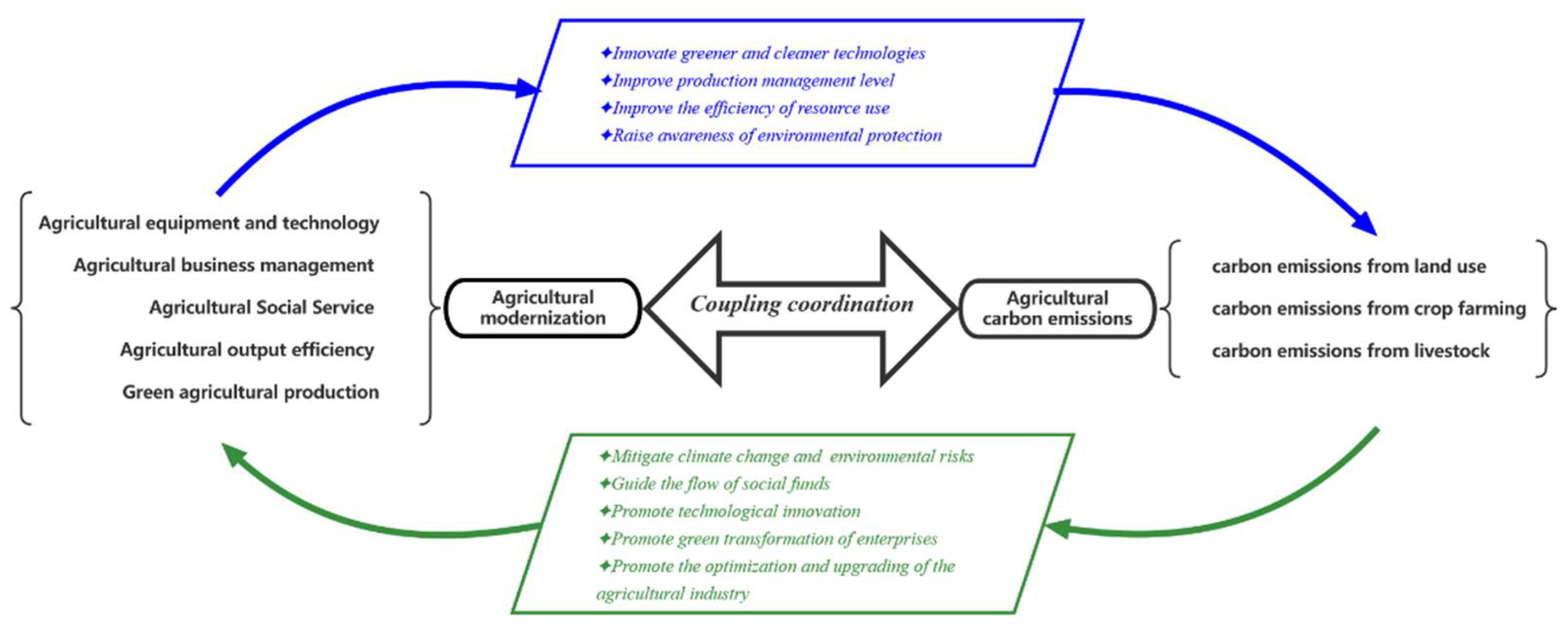

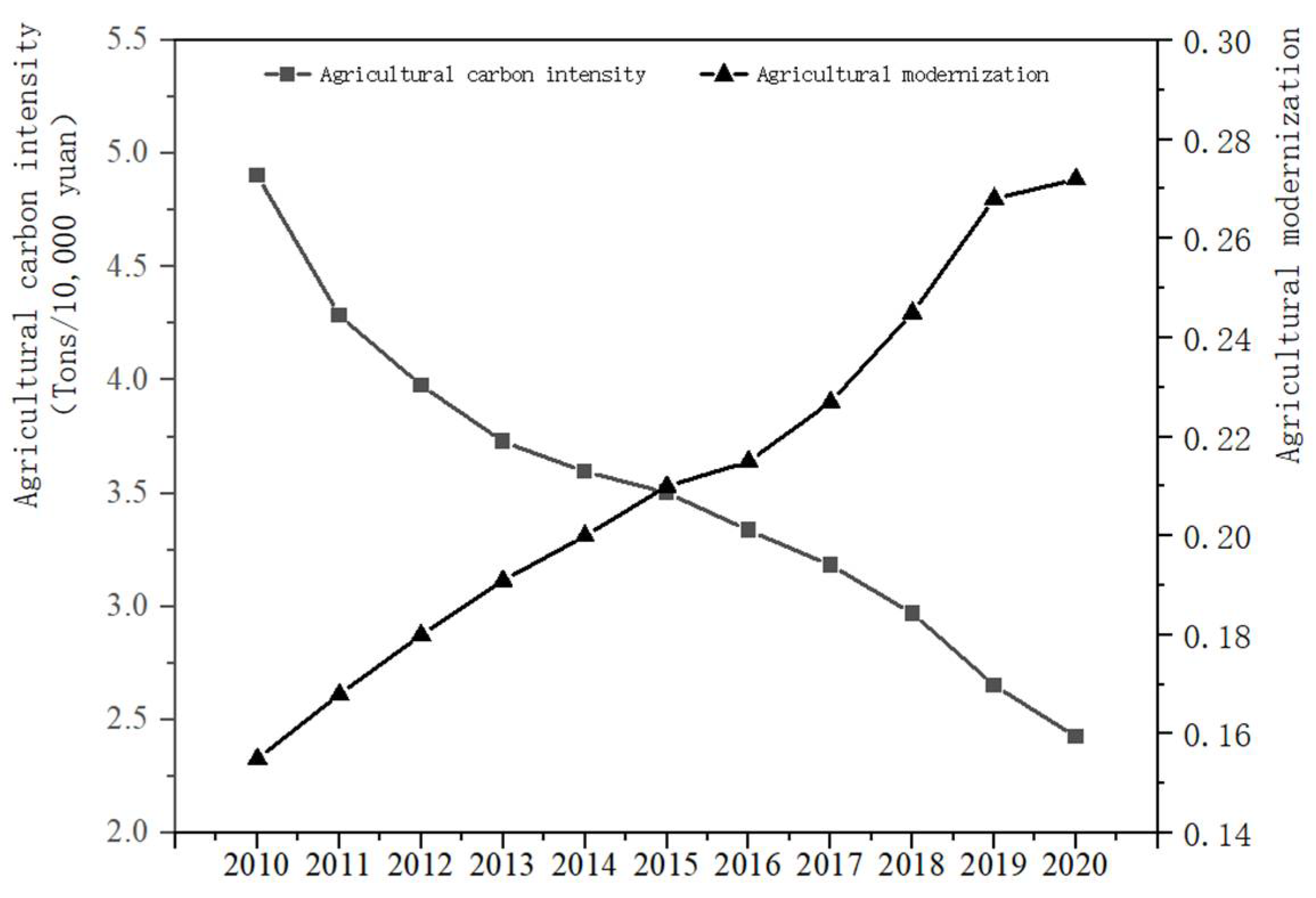
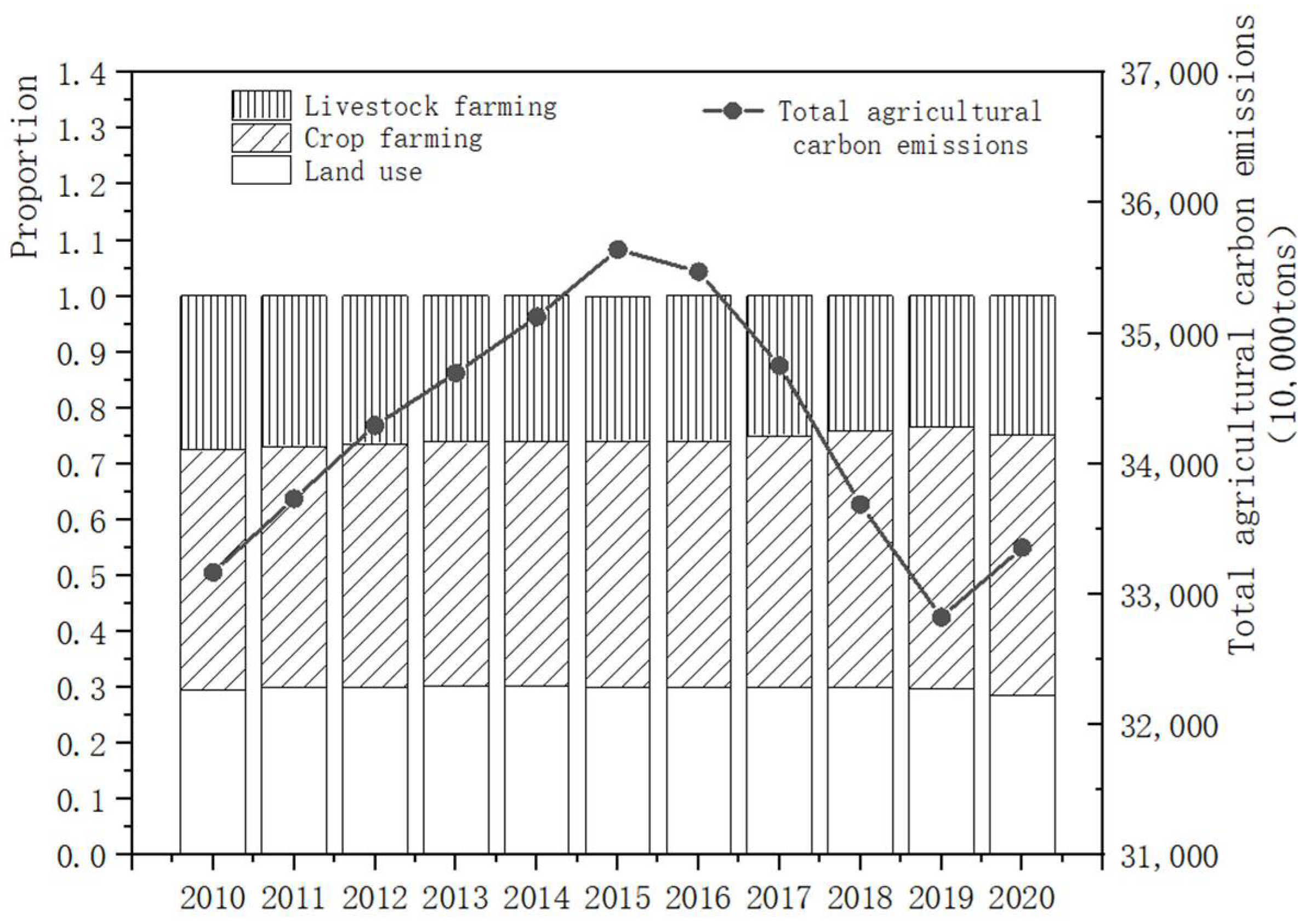
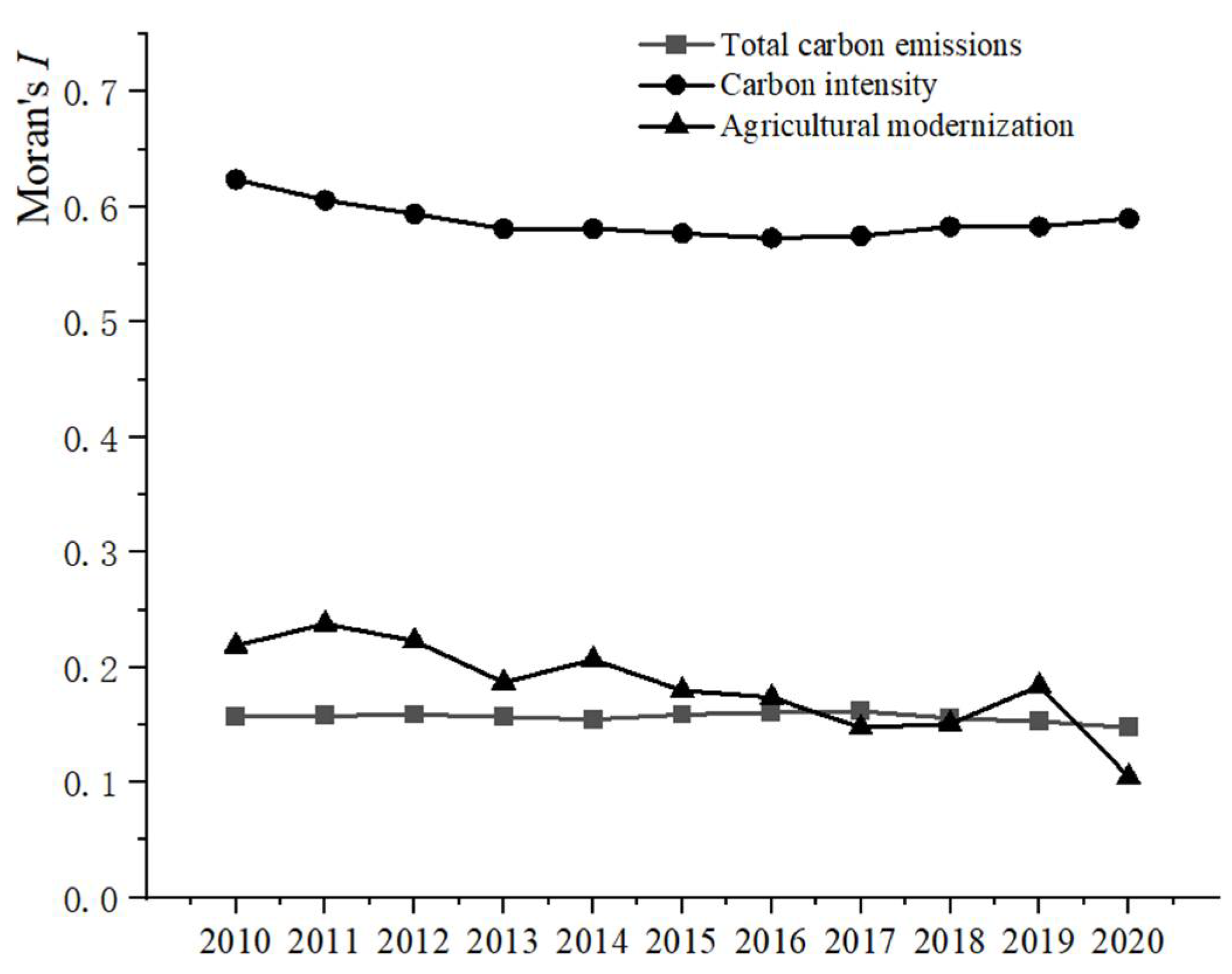

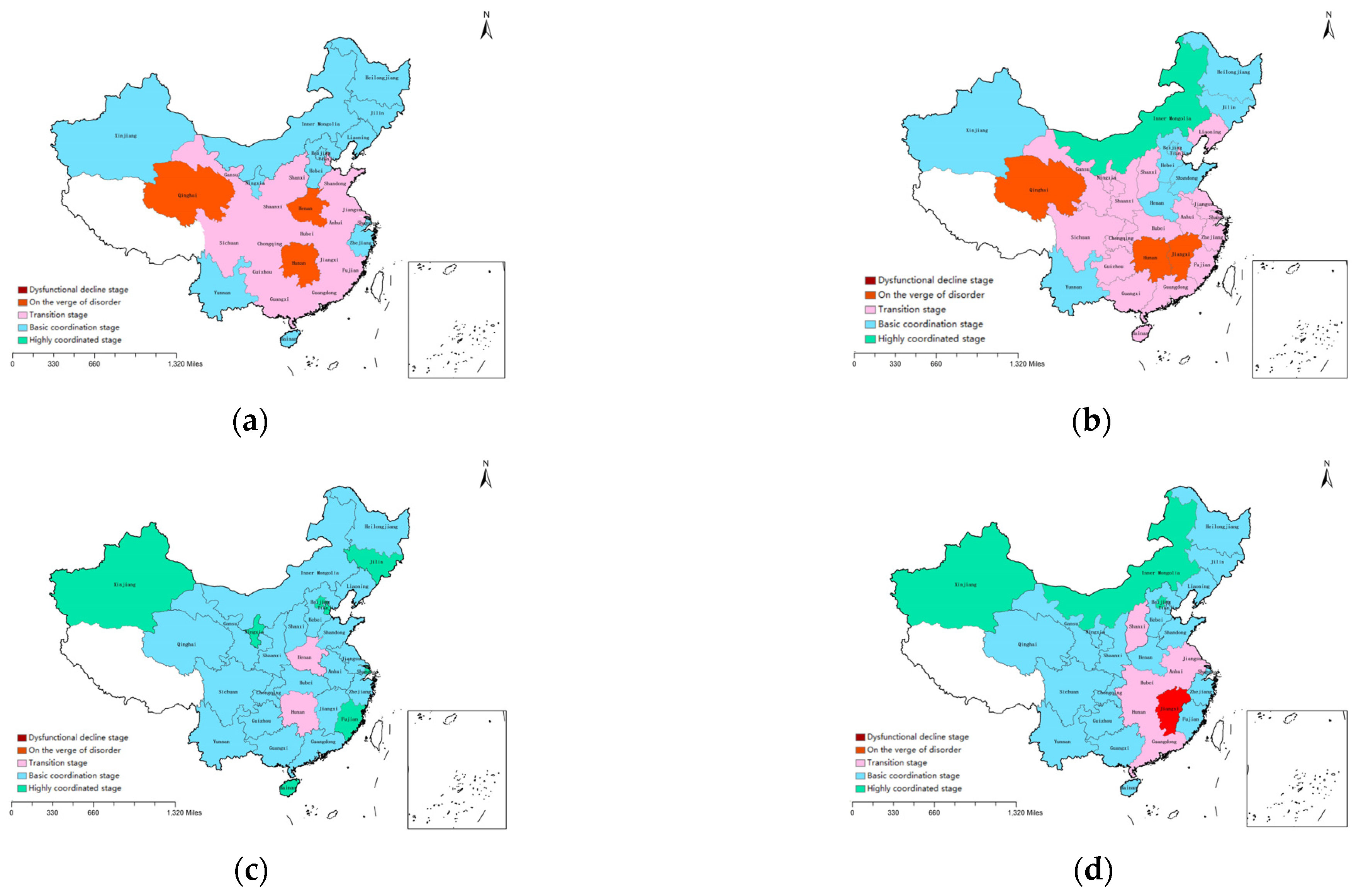


| Target Layer | Indicators | Indicator Calculations | Direction | Weight |
|---|---|---|---|---|
| Agricultural equipment and technology | Level of agricultural mechanization | Total agricultural machinery power (10 thousand kilowatts) | + | 0.0910 |
| Level of agricultural irrigation | Effective irrigated farmland/total cultivated area (%) | + | 0.0288 | |
| Level of agricultural informatization | Rural broadband access users/total rural households (%) | + | 0.0828 | |
| Agricultural business management | Moderate-scale operations | Number of households with cultivated land area of 2 hectares or above/total number of households (%) | + | 0.1996 |
| Farm land scaling and land transfer | Proportion of households with more than 0.67 hectares cultivated land × 0.5 + Proportion of total transferred land of total cultivated land × 0.5 (%) | + | 0.0876 | |
| Agricultural disaster prevention rate | 1 − (Disaster area of crops/sown area of crops) (%) | + | 0.0980 | |
| Disposable income per rural residents | Per capita disposable income of rural residents (Chinese yuan/person) | + | 0.0540 | |
| Agricultural Social Service | Farmer organization level | Number of rural cooperative members/total number of peasant households (%) | + | 0.0687 |
| Agricultural socialization service level | Number of specialized agricultural machinery service institutions/number of peasant households (%) | + | 0.0832 | |
| Depth of agricultural insurance | Total agricultural insurance premiums/GDP from agriculture sector (%) | + | 0.1130 | |
| Agricultural output efficiency | Agricultural labor productivity | Average value added of each agricultural employee (Chinese yuan/person) | + | 0.0521 |
| Land productivity | Output value of plantation per unit area (Chinese yuan/ha) | + | 0.0700 | |
| Grain productivity | Grain yield (kg/ha) | + | 0.0251 | |
| Green agricultural production | Water usage per unit of agricultural added value | Water usage/GDP from agriculture sector (kg/CNY 10,000) | − | 0.0068 |
| Energy consumption per unit of agricultural added value | Total diesel usage in agriculture/GDP from agriculture sector (kg/CNY 10,000) | − | 0.0147 | |
| Fertilizer reduction | Annual sequential reduce rate in fertilizer (%) | − | 0.0099 | |
| Pesticide reduction | Annual sequential reduce rate in pesticides (%) | − | 0.0029 |
| Coupling Degree | Coupling Stage |
|---|---|
| (0.0~0.3) | Low-level coupling stage |
| [0.3~0.5) | Basic coupling stage |
| [0.5~0.8) | Moderate coupling stage |
| [0.8~1.0) | High-level coupling stage |
| Coordination Stage | Coupling Coordination Degree | Coordination Level |
|---|---|---|
| Seriously dissonant stage | (0.0, 0.1) | Extreme imbalance |
| [0.1, 0.2) | Serious imbalance | |
| Slightly dissonant stage | [0.2, 0.3) | Moderate imbalance |
| [0.3, 0.4) | Mild imbalance | |
| Basic coordination stage | [0.4, 0.5) | On the verge of imbalance |
| [0.5, 0.6) | Near coordination | |
| Moderately coordinated stage | [0.6, 0.7) | Primary coordination |
| [0.7, 0.8) | Moderate coordination | |
| Superiorly coordinated stage | [0.8, 0.9) | Good coordination |
| [0.9, 1.0) | Extreme coordination |
| Total Carbon Emissions | Carbon Emission Intensity | Agricultural Modernization | |||||||
|---|---|---|---|---|---|---|---|---|---|
| 2010 | 2015 | 2020 | 2010 | 2015 | 2020 | 2010 | 2015 | 2020 | |
| Max | 2880.9 | 3045.9 | 2714.4 | 0.742 | 0.738 | 0.761 | 0.307 | 0.379 | 0.404 |
| Min | 66.8 | 50.8 | 24.9 | 0.013 | 0.013 | 0.013 | 0.081 | 0.130 | 0.188 |
| Mean | 1105.6 | 1188.1 | 1111.9 | 0.366 | 0.373 | 0.397 | 0.155 | 0.210 | 0.272 |
| S.D. | 765.0 | 822.9 | 761.8 | 0.182 | 0.182 | 0.188 | 0.054 | 0.061 | 0.057 |
| Median | 910.8 | 1146.5 | 1119.3 | 0.353 | 0.376 | 0.415 | 0.142 | 0.199 | 0.264 |
| Total Moran’s I (D1) | E (I) | Sd (I) | Z | p-Value | |
| 2010 | 0.192 | −0.034 | 0.120 | 1.879 | 0.030 |
| 2015 | 0.229 | −0.034 | 0.113 | 2.336 | 0.010 |
| 2020 | 0.262 | −0.034 | 0.118 | 2.516 | 0.006 |
| Intensity Moran’s I (D2) | E (I) | Sd (I) | Z | p-Value | |
| 2010 | 0.214 | −0.034 | 0.120 | 2.069 | 0.019 |
| 2015 | 0.346 | −0.034 | 0.117 | 3.255 | 0.001 |
| 2020 | 0.397 | −0.034 | 0.115 | 3.758 | 0.000 |
Publisher’s Note: MDPI stays neutral with regard to jurisdictional claims in published maps and institutional affiliations. |
© 2022 by the authors. Licensee MDPI, Basel, Switzerland. This article is an open access article distributed under the terms and conditions of the Creative Commons Attribution (CC BY) license (https://creativecommons.org/licenses/by/4.0/).
Share and Cite
Xia, M.; Zeng, D.; Huang, Q.; Chen, X. Coupling Coordination and Spatiotemporal Dynamic Evolution between Agricultural Carbon Emissions and Agricultural Modernization in China 2010–2020. Agriculture 2022, 12, 1809. https://doi.org/10.3390/agriculture12111809
Xia M, Zeng D, Huang Q, Chen X. Coupling Coordination and Spatiotemporal Dynamic Evolution between Agricultural Carbon Emissions and Agricultural Modernization in China 2010–2020. Agriculture. 2022; 12(11):1809. https://doi.org/10.3390/agriculture12111809
Chicago/Turabian StyleXia, Mengyao, Di Zeng, Qi Huang, and Xinjian Chen. 2022. "Coupling Coordination and Spatiotemporal Dynamic Evolution between Agricultural Carbon Emissions and Agricultural Modernization in China 2010–2020" Agriculture 12, no. 11: 1809. https://doi.org/10.3390/agriculture12111809
APA StyleXia, M., Zeng, D., Huang, Q., & Chen, X. (2022). Coupling Coordination and Spatiotemporal Dynamic Evolution between Agricultural Carbon Emissions and Agricultural Modernization in China 2010–2020. Agriculture, 12(11), 1809. https://doi.org/10.3390/agriculture12111809







